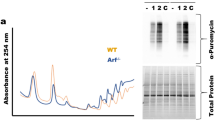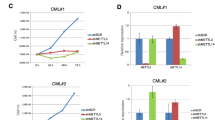Abstract
The 5′ untranslated region of the proto-oncogene c-myc contains an internal ribosome entry segment (IRES) (Nanbru et al., 1997; Stoneley et al., 1998) and thus c-myc protein synthesis can be initiated by a cap-independent as well as a cap-dependent mechanism (Stoneley et al., 2000). In cell lines derived from patients with multiple myeloma (MM) there is aberrant translational regulation of c-myc and this correlates with a C-T mutation in the c-myc-IRES (Paulin et al., 1996). RNA derived from the mutant IRES displays enhanced binding of protein factors (Paulin et al., 1998). Here we show that the same mutation is present in 42% of bone marrow samples obtained from patients with MM, but was not present in any of 21 controls demonstrating a strong correlation between this mutation and the disease. In a tissue culture based assay, the mutant version of the c-myc-IRES was more active in all cell types tested, but showed the greatest activity in a cell line derived from a patient with MM. Our data demonstrate that a single mutation in the c-myc-IRES is sufficient to cause enhanced initiation of translation via internal ribosome entry and represents a novel mechanism of oncogenesis.
This is a preview of subscription content, access via your institution
Access options
Subscribe to this journal
Receive 50 print issues and online access
$259.00 per year
only $5.18 per issue
Buy this article
- Purchase on Springer Link
- Instant access to full article PDF
Prices may be subject to local taxes which are calculated during checkout



Similar content being viewed by others
References
Auscbel RM. . 1987 In: Current Protocols in Molecular Biology. Greene J. (ed.) Wiley-Interscience: New York. pp. 11–9.17.
Bernstein J, Sella O, Le S and Elroy-Stein O. . 1997 J. Biol. Chem. 272: 9356–9362.
Choczynski P and Sacchi N. . 1987 Analyt. Biochem. 162: 156–159.
Coldwell M, Mitchell S, Stoneley M, MacFarlane M and Willis A. . 2000 Oncogene 19: 899–907.
Dang C. . 1999 Mol. Cell Biol. 19: 1–11.
Evan GI and Littlewood TD. . 1993 Curr. Opin. Genet. Dev. 3: 44–49.
Gray N and Wickens M. . 1998 Annu. Rev. Cell Dev. Biol. 14: 399–458.
Holcik M, Lefebvre C, Ye C, Chow T and Korneluk R. . 1999 Nature Cell Biol. 1: 190–192.
Lee CH, Leeds P and Ross J. . 1998 J. Biol. Chem. 273: 25261–25271.
Lüscher B and Eisenmann RN. . 1988 Mol. Cell. Biol. 8: 2504–2512.
Martinez-Salas E, Saiz J-C, Davila M, Belsham GJ and Domingo E. . 1993 J. Virol. 67: 3748–3755.
Miller D, Dibbens J, Damert A, Risau W, Vadas M and Goodall G. . 1998 FEBS Letts. 434: 417–420.
Nanbru C, Lafon I, Audiger S, Gensac G, Vagner S, Huez G and Prats A-C. . 1997 J. Biol. Chem. 272: 32061–32066.
Neri A, Barriga F, Knowles DM, Magrath IT and Dalla-Favera R. . 1988 Proc. Natl., Acad. Sci. USA 85: 2748–2752.
Niesvizky R, Siegel D and Michaeli J. . 1993 Blood Rev. 7: 24–33.
Pain VM. . 1996 Eur. J. Biochem. 236: 747–771.
Paulin FEM, Chappell SA and Willis AE. . 1998 Nucleic Acids Res. 26: 3097–3103.
Paulin FEM, West MJ, Sullivan NF, Whitney RL, Lyne L and Willis AE. . 1996 Oncogene 13: 505–513.
Pelicci P, Knowles DM, Magrath IT and Dalla-Favera R. . 1986 Proc. Natl. Acad. Sci. USA 2984–2988.
Ross J. . 1995 Microbiol. Rev. 59: 16–95.
Schwab M, Klempnauer K-H, Alitalo K, Varmus H and Bishop M. . 1986 Mol. Cell. Biol. 6: 2752–2755.
Shindo H, Tani E, Matsumuto T, Hashimoto T and Furuyama J. . 1993 Acta Neuropathologica 86: 345–352.
Stein I, Itin A, Einat P, Skaliter R, Grossman Z and Keshet E. . 1998 Mol. Cell. Biol. 18: 3112–3119.
Stoneley M, Paulin FEM, LeQuesne JPC, Chappell SA and Willis AE. . 1998 Oncogene 16: 423–428.
Stoneley M, Subkhankulova T, Le Quesne J, Coldwell M, Jopling C, Belsham G and Willis A. . 2000 Nucleic Acids Res. 28: 687–694.
Sumegi J, Hedberg T, Bjorkholm M, Godal T, Mellstedt H, Nilsson MG, Perlman C and Klein G. . 1985 Int. J. Cancer 36: 367–371.
Vagner S, Gensac M-C, Maret A, Bayard F, Amalric F, Prats H and Prats A-C. . 1995 Mol. Cell. Biol. 15: 35–44.
Watt R, Nishikaura K, Sorrentino J, ar-Rushdi A, Croce CM and Rovera G. . 1983 Proc. Natl. Acad. Sci. USA 80: 6307–6311.
West MJ, Sullivan NF and Willis AE. . 1995 Oncogene 13: 2515–2524.
Acknowledgements
This work was funded by grants from the Leukaemia Research Fund (SA Chappell, M de Schoolmeester and M Helfrich), Medical Research Council (FEM Paulin; JPC LeQuesne, held a MRC studentship) and the Cancer Research Campaign (M Stoneley) and the BBSRC (advanced fellowship to AE Willis).
Author information
Authors and Affiliations
Rights and permissions
About this article
Cite this article
Chappell, S., LeQuesne, J., Paulin, F. et al. A mutation in the c-myc-IRES leads to enhanced internal ribosome entry in multiple myeloma: A novel mechanism of oncogene de-regulation. Oncogene 19, 4437–4440 (2000). https://doi.org/10.1038/sj.onc.1203791
Received:
Revised:
Accepted:
Published:
Issue Date:
DOI: https://doi.org/10.1038/sj.onc.1203791
Keywords
This article is cited by
-
DAP5 increases axonal outgrowth of hippocampal neurons by enhancing the cap-independent translation of DSCR1.4 mRNA
Cell Death & Disease (2019)
-
Human rhinovirus internal ribosome entry site element enhances transgene expression in transfected CHO-S cells
Scientific Reports (2018)
-
Functional 5′ UTR mRNA structures in eukaryotic translation regulation and how to find them
Nature Reviews Molecular Cell Biology (2018)
-
The small molecule ‘1-(4-biphenylylcarbonyl)-4-(5-bromo-2-methoxybenzyl) piperazine oxalate’ and its derivatives regulate global protein synthesis by inactivating eukaryotic translation initiation factor 2-alpha
Cell Stress and Chaperones (2016)
-
The feed-forward loop between YB-1 and MYC is essential for multiple myeloma cell survival
Leukemia (2013)



